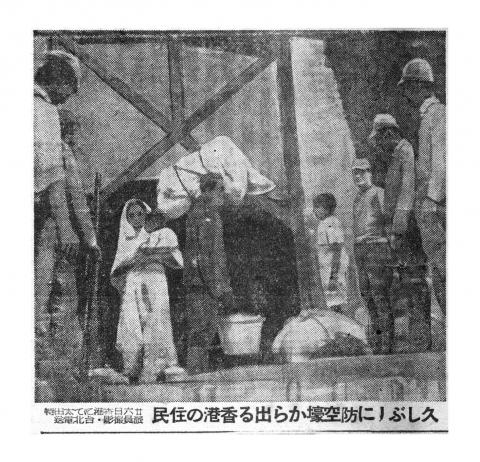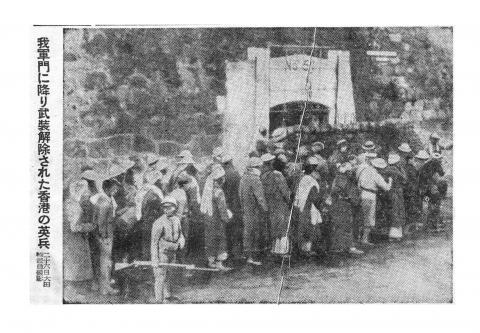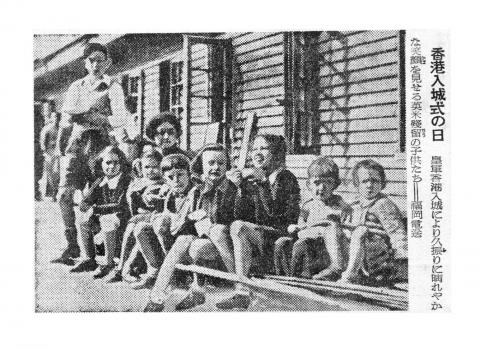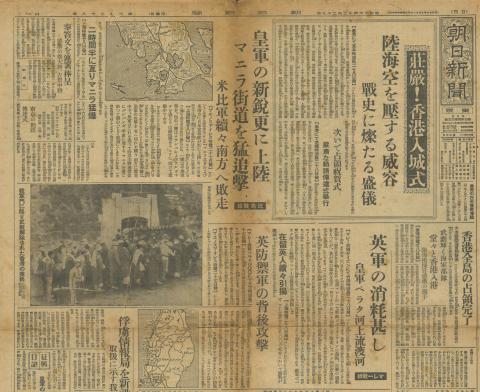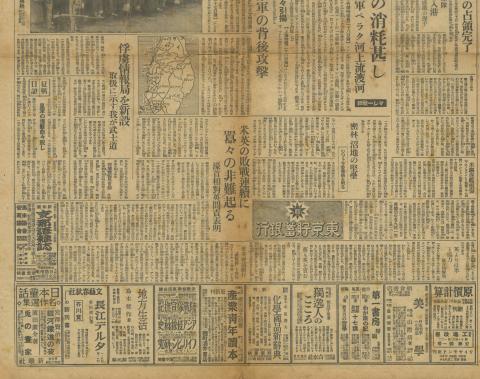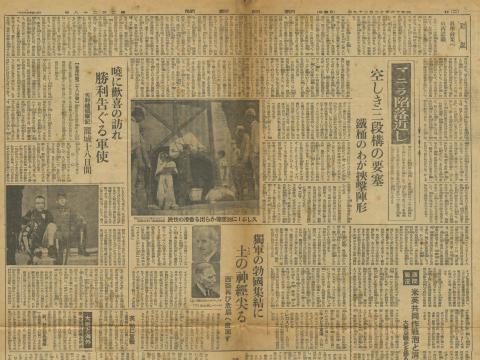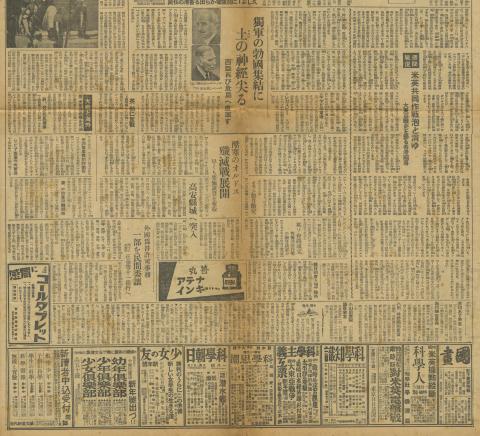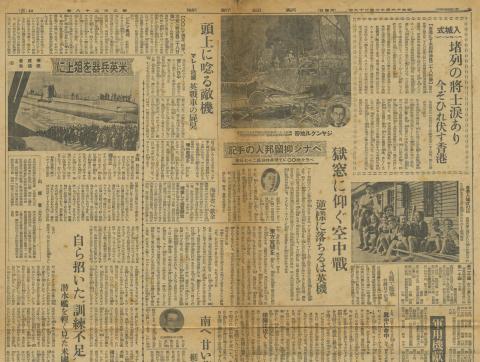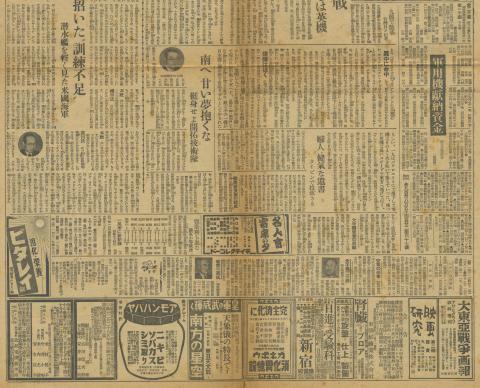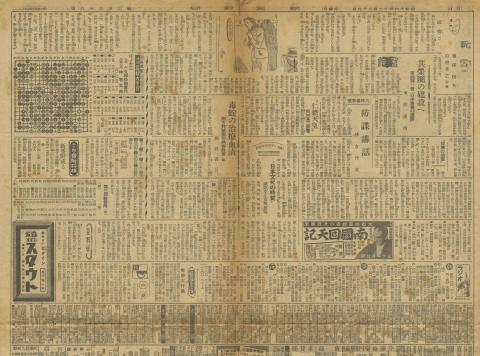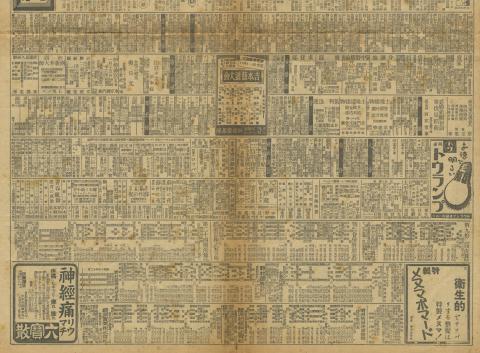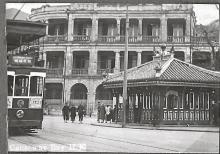70 years ago: Hong Kong's wartime diaries
29 Dec 1941. R. E. Jones Wartime diary
Submitted by Admin on Fri, 2011-12-23 15:05Book / Document:Date(s) of events described:Mon, 29 Dec 1941Foster turned up. ((Probably fellow Prison Officer, G.B. Foster))
Got a few more odds & ends from GII (Makes me sad to see our little home messed up pal). 2nd night. No news from outside of any sort, no radios going. So we do not know what the situation is.
29 Dec 1941. Japanese newspaper Asahi Shimbun reports "Ceremonial entry into Hong Kong by Imperial Japanese Army and Navy"
Submitted by David on Thu, 2011-12-29 23:28Book / Document:Date(s) of events described:Mon, 29 Dec 1941I bought this Japanese newspaper on eBay a couple of years ago. I can't read any Japanese, but the seller included this description:
The main headline is:
"Ceremonial entry into Hong Kong by Imperial Japanese Army and Navy "
Some articles and pictures:
- Japan flag stands at the Victoria Park, Hong Kong
- Commander Sakai and Japan troops parade through Hong Kong
- Celebration for occuping Hong Kong held
- Occupation of all islands of Hong Kong is complete
- Japan troops bombs Manila
- Map: around Manila, the Philippines
- Report from Manila: Manila fallen soon
- Picture: Hong Kong residents come out of Air-raid Shelter
- Picture: British soldiers disarmed in Hong Kong
- Picture: Detained British and American children with smiles for Japanese victory in Hong Kong
- Analysis: How to fight against British and American weapons
- Picture: British HMS Unity (N66)
- Unque commercial ads
- etc,
Here are complete scans of the newspaper pages (click any thumbnail for a larger view). Thanks to Paul Wan and his friend, we now have translations of the articles that mention Hong Kong. Paul writes:
You and I have a New Year gift from my friend in Vancouver, who translated the gist of the newspaper for Gwulo fans. He said that the newspaper is in classic (old) Japanese. You may share the content in Gwulo.
Thanks again to Paul and his friend. I'll paste in the translations below.
Page 1 – six headlines/columns mention about Hong Kong
- Headline: 莊嚴!香港入城式 (Solemn! Hong Kong City Entering Ceremony)
In the morning of the 28th the weather was good. At the hill top in Hong Kong Island: the Victoria Peak, the Japanese flag was flying. It was a good day for holding the city entering ceremony. Sakai, the Supreme Commanding Officer in HK at 2.00 pm departed for the ceremony. He inspected the parade at the Boundary Street etc. Then from Kowloon he traveled to Hong Kong Island. At So Kwan Po he greeted the platoons from the army and the navy. Later together with high ranking officers, he inspected the parading army on horse in Central. The city entering ceremony was ended at 4.10 pm, then in a car Sakai was driven to the Governor House located at the middle of a hill. The air force and the navy also had contributed performance for the ceremony. - Headline: 次いて占領祝賀式 (The Occupation Cerebration Ceremony that Followed)
After the city entering ceremony was over, senior officers at the parade arrived at the Governor House at 4.30 pm to take a break. Then at the open space outside the Governor House a ceremony was held. The supreme army commander Sakai made a speech and the ceremony was ended by photo taking. Inside the building there were singing and dancing and toasting, the event was ended at 5.30 pm. - Headline: 征戰日記 (War Campaign Diary)
In the occupation of Hong Kong, the army and the navy disarmed the enemy on the 26th afternoon and occupied the whole island. On the 27th the Navy entered the harbor. On the 28th the city entering ceremony was held. . . (This column continues to talk about other war fronts at locations outside Hong Kong) - Headline: 香港の在米資產凍結 (Hong Kong’s Assets in the US Frozen)
(News released from Buenos Aires) The United States Finance Minister announced the frozen of HK assets in the US when Hong Kong came under the Japanese occupation. - Headline:香港全島占領完了(Hong Kong Whole Island Occupation Completed)
Hong Kong Island had been completely occupied. The Imperial Army and Navy charged with the duty to attack Hong Kong had disarmed the enemy. They were disarmed on the 26th at 6.00 pm and the whole island was occupied. - Headline:武熏力輝く海軍部隊 堂タと香港入港 (The Navy with a Commanding Presence, Entering Hong Kong Harbor with anImpressive Bearing)
Before the city entering ceremony, the Navy in Hong Kong made a splendid appearance in the Hong Kong’s waters on the 27th at 10.00 am. At 3.00 pm on the same day, the Navy senior officials visited the Supreme Commander Sakai. They shook hand to express thanks for breaking the British’s 100-year dream of imperial invasion in S.E. Asia. The navy had been on alert to the possible escape of the British gun boats and torpedo boats etc. They shot at and sank torpedo boats that tried to escape at high speed. They cut the cable line under the sea, stopping Hong Kong’s connection with the outside and thus isolated Hong Kong Island. They attacked the Stone Cutter Island and occupied the war supply depot, and subsequently the army could land at the Kowloon Peninsula. On 26th when entering Hong Kong the navy met not even one enemy boat. In total they captured over 200 boats of various descriptions.
Page 2 - one headline is related to Hong Kong
Headline: 曉に歡喜の訪れ 勝利告ぐる軍使 (A Happy Visit at Dawn, Army Visitors that Announced the Victory)
(It is an article written by Yano, the chief Japanese Consular General in Hong Kong and he sent it to the Asahi Newspaper for publishing. The title’s article was “Eighteen Days in a Surrounded City”)
On December 12th the Chief Consular General of Japan in Hong Kong together with other Japanese (mostly heads of big Japanese organizations in Hong Kong) visited the Japanese prisoners locked up by the British in the Stanley Prison to give them courage and spiritual support. On their return trip back to the residence of the Consular General they encounter shelling and other dangers. When they arrived at the Consular residence and stayed. On the 25th at 4.45 pm they knew that the British had surrendered and they immediately disarmed the British soldiers guarding the Consular residence. On 26th December at 4.40 am they were visited by three officials from the Japanese Army to inform them about the defeat of the British forces in Hong Kong.
Page 3 - two headlines are related to Hong Kong
Headline: 堵列の將士淚あり 今ぞひれ伏す香港 (The Soldiers and Officers in the Lining-up Were With Tears, Now Hong Kong groveled at my feet)
The city entering ceremony held on the 28th December was started at 3.00 pm. Along Queen’s Road; there was a two-mile long army and navy parade. It was followed by a victory celebration ceremony at the Hong Kong Governor’s House. The business center near the Hong Kong and Shanghai Bank was flying a Japanese flag. There were those Japanese who had been locked up for 18 days and now released to freedom from the hands of the Japanese Imperial army. There planes flew pass from the west. At the So Kwan Po, the military band played music. The parading soldiers had tears on the face and were gratifying their fallen comrades.
Headline: 九龍で散華 台灣日タ 記者 (A Taiwan Reporter Died in Kowloon)
A Japanese army reporter from Taiwan was killed by shrapnel that hit at his heart on 23rd shortly after 11.00 am while he was staying with a marine detachment.
Page 4 - no news about Hong Kong
There is more background information about this Japanese newspaper company available on Wikipedia.
29 Dec 1941, Chronology of Events Related to Stanley Civilian Internment Camp
Submitted by brian edgar on Tue, 2012-12-04 00:16Book / Document:Date(s) of events described:Mon, 29 Dec 1941The water supply is restored in Victoria (now Central).
At Argyle Street Camp Dr. Newton sees the Japanese guard salute as a dead British soldier is carried out. He's not impressed: he wishes the Japanese had taken more trouble with the living.
Sources:
Water: G. B. Endacott and Alan Birch, Hong Kong Eclipse, 1978, 115
Dr. Newton: Oliver Lindsay, The Lasting Honour, 1980 ed., 164
29 Dec 1941, Harry Ching's wartime diary
Submitted by Admin on Wed, 2013-01-02 22:37Book / Document:Date(s) of events described:Mon, 29 Dec 1941Conditions are easing a little back to normal. To our joy, coolies appeared and began sweeping the garbage into large heaps. Then a Sanitary Department van with a European in charge came to take the rubbish away. To our disappointment, it made only one trip and the district stank as before.
Nephew Fred and I went to the racecourse stands to inquire for his mother, of whom we have had no news since the relief hospital was over-run on Christmas Eve. The place seemed deserted, but as we neared the gate a Japanese N.C.O. suddenly appeared. Hostile, he shouted at us, then beckoned us to approach. We tried in Chinese to explain our mission, but he showed no understanding. The more we tried the more annoyed he became. "Better beat it," I muttered to Fred, "he's getting nasty." But he would not let us go, and continued to shout as we stood silently before him. Then suddenly he said, "Spik Ingrese." We brightened and he grinned. We explained it all again in English. He pointed to a big closed door at the end of the stands. We pushed it open and went in. It was the hospital morgue, with three male bodies lying on tables. We quickly withdrew. He laughed and motioned to the main grandstand. This was deserted and in confusion, beds empty and blankets and furnishings strewn around. We thanked him again and offered him a cigarette, which he refused.
Near the cemeteries outside the grandstand we met Arthur May of the Public Works Department. He had walked across the Island from the Dairy Farm on the south side. He eased our anxiety, had seen Fred's mother at the Queen Mary Hospital.
At the Monument a scene of desolation presented itself. Smashed and burnt vehicles stood about. The buildings had all been peppered with shell-fire, and the Golf Club pavilion and Texas oil station are badly wrecked. Under a truck lay the body of a woman. Presently, a discordant clanking overtook us. Wrecked vehicles were being towed into the centre of the racecourse and dumped there. I failed to recognise mine among them.
Next the ping of rifle shots alerted us and we ducked. But the targets were far away, on the other side of the Valley. The Japanese were firing on the looters whom we could see scurrying for cover on Broadwood Ridge.
29 Dec 1941, Colin McEwan Diary
Submitted by Alison McEwan on Sun, 2022-01-02 11:16Book / Document:Date(s) of events described:Mon, 29 Dec 1941Rumours of bicycle taxis for all of us were prevalent this morning but evidently it was not to be since, falling into separate groups in case of air raid, we moved off as usual. So still in my role of Commander of M.T.B.28 we started covering the road at a good heel and toe pace. Spirits were high and the mouth organ suddenly produced by Pony Moore lifted our feet along the moorland road we were covering. One very welcome halt we had at a wayside teashop – later to prove a howff of Tai’s and mine where doughnuts vanished like “snow off a dike”.
And so we came to Waichow – and halted on the outskirts for tea and cakes. While there we noticed a constant stream of Chinese soldiers passing through – Yu Hon Mau’s troops who were to have relieved HK and who were now on their way to Changsa where for the third time the J’s were to be thrown back. Another – at least for us who by hearsay only knew of W.R.N.s etc – new sight was the appearance of the first of the Chinese Army comfort corps of girls whose job it is to write letters for the troops, do propaganda work among the villages and such work. (From my diary I see Edna is recorded as “First sight of Chinese woman soldier – speaks good English”).
Then came our parade into town – a long procession in columns of three – in the front Chinese and British flags – officers on the flank beside their crews – trying manfully to keep them in step. Impressive it may have been – certainly the town turned out to watch – but the general impression it gave me – slinking along in the rear and beginning to realise how dirty I was – was that of a Salvation Army Saturday night route march just at closing time. In addition to this I felt an irresistible urge to giggle and in this was not helped by the fact that the mouth organ band was playing the Beer Barrel Polka followed by MacMillan’s rendering of “I don’t want to be a soldier” while striding along with a definitely martial air.
Quarters were found in the local mission hospital and after the luxury of a real bath we were entertained to dinner and wine by the local H.Q. where it was again proved that the Navy cannot be beat – Ronny Ashby by some form of magic appearing in collar and tie and looking like a very senior Rear Admiral. And so to bed – real beds – and sleep, real sleep.
